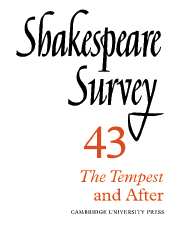Book contents
- Frontmatter
- The Power of Magic: From Endimion to The Tempest
- Reading The Tempest
- The Latter End of Prospero’s Commonwealth
- Henry VIII and the Deconstruction of History
- The Politics of Conscience in All is True (or Henry VIII)
- Shakespeare’s Romantic Innocents and the Misappropriation of the Romance Past: The Case of The Two Noble Kinsmen
- The Hand of John Fletcher in Double Falsehood
- ‘The Duke my Father’s Wrack’: The Innocence of the Restoration Tempest
- ‘Remember/First to Possess his Books’: The Appropriation of The Tempest 1700-1800
- The Tempest and After
- Poetry’s Sea-Changes: T. S. Eliot and The Tempest
- The New Function of Language in Shakespeare’s Pericles: Oath versus ‘Holy Word’
- The Discovery of The Rose Theatre: Some Implications
- The Origins of the Roxana and Messallina Illustrations
- Recycling the Early Histories: ‘The Wars of the Roses’ and ‘The Plantagenets’
- Shakespeare Production in England in 1989
- Professional Shakespeare Productions in the British Isles, January-December 1988
- The Year's Contributions to Shakespeare Studies: 1 Critical Studies
- 2 Shakespeare’s Life, Times, and Stage
- 3 Editions and Textual Studies
- Books Received
- Index
‘The Duke my Father’s Wrack’: The Innocence of the Restoration Tempest
Published online by Cambridge University Press: 28 March 2007
- Frontmatter
- The Power of Magic: From Endimion to The Tempest
- Reading The Tempest
- The Latter End of Prospero’s Commonwealth
- Henry VIII and the Deconstruction of History
- The Politics of Conscience in All is True (or Henry VIII)
- Shakespeare’s Romantic Innocents and the Misappropriation of the Romance Past: The Case of The Two Noble Kinsmen
- The Hand of John Fletcher in Double Falsehood
- ‘The Duke my Father’s Wrack’: The Innocence of the Restoration Tempest
- ‘Remember/First to Possess his Books’: The Appropriation of The Tempest 1700-1800
- The Tempest and After
- Poetry’s Sea-Changes: T. S. Eliot and The Tempest
- The New Function of Language in Shakespeare’s Pericles: Oath versus ‘Holy Word’
- The Discovery of The Rose Theatre: Some Implications
- The Origins of the Roxana and Messallina Illustrations
- Recycling the Early Histories: ‘The Wars of the Roses’ and ‘The Plantagenets’
- Shakespeare Production in England in 1989
- Professional Shakespeare Productions in the British Isles, January-December 1988
- The Year's Contributions to Shakespeare Studies: 1 Critical Studies
- 2 Shakespeare’s Life, Times, and Stage
- 3 Editions and Textual Studies
- Books Received
- Index
Summary
‘What care these roarers for the name of Duke?’ exclaims Trincalo, the Boatswain in The Enchanted Island, Dryden and Davenant’s adaptation of the Tempest; ‘to Cabin; silence; trouble us not’ (1.1.22). The temptation to see this as one of the absurdities of restoration royalism is strong. Driven by the desire to expunge any critique of monarchy from the plays of an earlier generation, the adaptors replaced the name of king with the name of duke. The ocean’s ‘roarers’ no longer suggest a crowd resentful of divine right claims, and the Boatswain is guilty of a certain rudeness to a duke but not of the more frightening crime of lèsemajesté. The duke’s notion that his ‘name’ might still the storm becomes itself absurd; only the name of king can match the force of nature. And it is a name that is not spoken in Dryden and Davenant’s play.
The traumas of civil wars, regicide, and restoration seem to have locked the theatre into a state of denial, at least until the 1680s, when opposition voices would again be heard in Parliament and (briefly) upon the stage. Heroic dramas indeed concentrated upon conflicts of allegiance and impossible divisions of loyalties, but did so in exotic settings, where an Amurath might succeed an Amurath, never a Harry a Harry, or a Charles a Charles.
- Type
- Chapter
- Information
- Shakespeare Survey , pp. 91 - 98Publisher: Cambridge University PressPrint publication year: 1991

